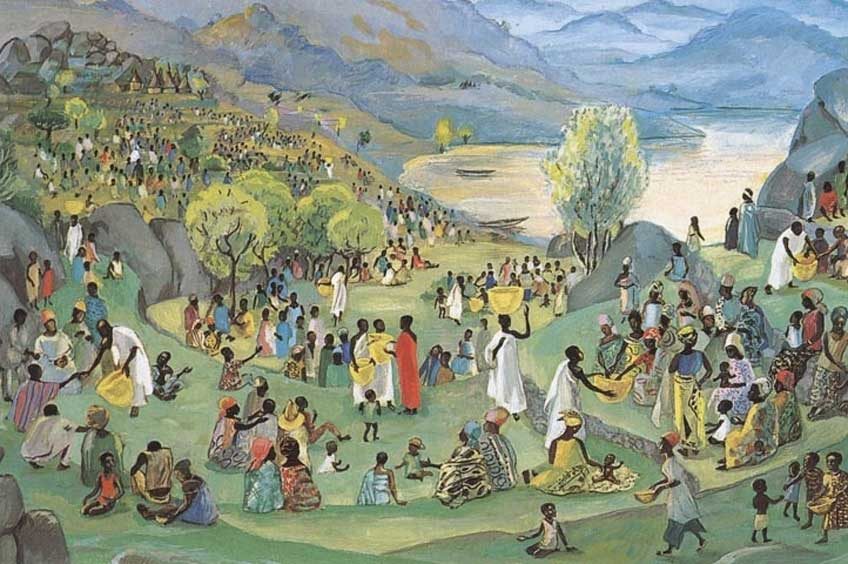Why is the story of Jesus feeding a multitude so important? It is the only miracle of Jesus that shows up in all four Gospels. In fact, it shows up six times in four Gospels because Matthew and Mark have both a feeding of five thousand and a feeding of four thousand.
Any story repeated so many times must be important. But what makes it so? This is the kind of question that biblical commentators love. Their answers are many. Some say the story is to remind us of the banquet of heaven. It is the story of the eucharist, the holy communion, and it anticipates the breaking of bread at the last supper. It is about sharing, say others. It is proof that Jesus is of God.
There is probably an element of truth in all the suggestions from the commentators, but five elements of the story speak to me. The first is the comment that the crowd was like “sheep without a shepherd.” Several Old Testament texts use the metaphor of the shepherd to refer to the king. It is possible that this is a political statement, a criticism of political economics that had led to much of the land in Galilee being owned by the wealthy in Jerusalem while the tenant farmers of Galilee were hungry.
A second is that the first response of Jesus was to teach. Mark says it simply: “[H]e saw a great crowd; and he had compassion for them, because they were like sheep without a shepherd; and he began to teach them many things” (Mark 6:34). One is tempted to believe that the deepest hunger of the crowd was the hunger of the mind for knowledge and of the soul for meaning. Perhaps the meal of bread and fish was really a symbol of the deeper feeding held in the teaching of Jesus.
The crowd, we are told, was over five thousand people. Quite probably the folks at the edges of a crowd that large would have difficulty hearing; yet they stayed. The teaching session must have been long because it lasted past meal time; yet they stayed. Surely the hunger for the message of Jesus was stronger than the hunger for food.
A third thing I notice is that the whole crowd was invited to the meal. We are told that certain sects of the Jews were very particular about their eating partners, yet this ragtag and motley group was invited to the Lord’s table with no discrimination whatsoever. Rich and poor, sinner and saint, victim and bully, all were welcome to the food Jesus offered.
And they all ate together. I like to think that Jesus invited them to eat together so they could discuss what they heard in his teaching. Was there some healing in the act of eating together? Did they recognize that their hungers were shared? Was there a new recognition of the importance of community?
A fourth surprise was the realization that Jesus did not feed the crowd. His disciples did. From the very first, this was the work of the disciples. It was the disciples who recognized that Jesus had been teaching quite a long time. Far too polite to suggest he end his message, the disciple subtly suggested, “This is a remote area, and it is now a very late hour. Why not send them away so that they may go to the countryside and villages and buy something to eat?”
Jesus’ response was direct, “You give them something to eat.” What does Jesus expect of disciples? Was Jesus trying to teach them to have compassion for the crowd as he did?
The disciples were stunned. “Should we go and buy enough food to feed five thousand?” If we back up to the preceding stories in chapter 6 of Mark, we see that the disciples had just returned from a mission. When they set out on that mission, Jesus told them to carry no money, no food, and no extra clothing. Now they have returned from the mission penniless and weary. They were just as poor and hungry as the multitude. Their suggestion about buying food only called attention to its impossibility.
Jesus did not let them off the hook. He continued assuming that the disciples should feed the crowd. “How much food do you have?” asked Jesus. “Check and see.” The disciples were able to come up with only five loaves and a couple of fish. But Jesus still did not offer to take responsibility. He told the disciples to seat the crowd and hand out the food. The only action attributed to Jesus in this story is that he blessed the food before it was distributed.
We are left wondering how five pita bread loaves and a couple of fish could feed five thousand. What is made clear, however, is that the feeding was done by the disciples and that Jesus blessed the meal.
Finally, we are told that everyone ate until they were satisfied and 12 baskets of leftovers were gathered. When we eat with Jesus there is more than enough to go around.
The story stops here, but I can imagine after it was over the disciples said to each other, “I didn’t think we could do it.”
Like the disciples on that day, there are times when I think more is asked of me than I can handle. I feel I do not have enough resources. I think I can’t do it. Maybe I can’t. But it is amazing what can happen to five loaves and a couple of fish offered in compassion and blessed by the spirit of Jesus.
An ordained minister, Bob Bowman is professor emeritus of religion at Manchester University, North Manchester, Indiana.


